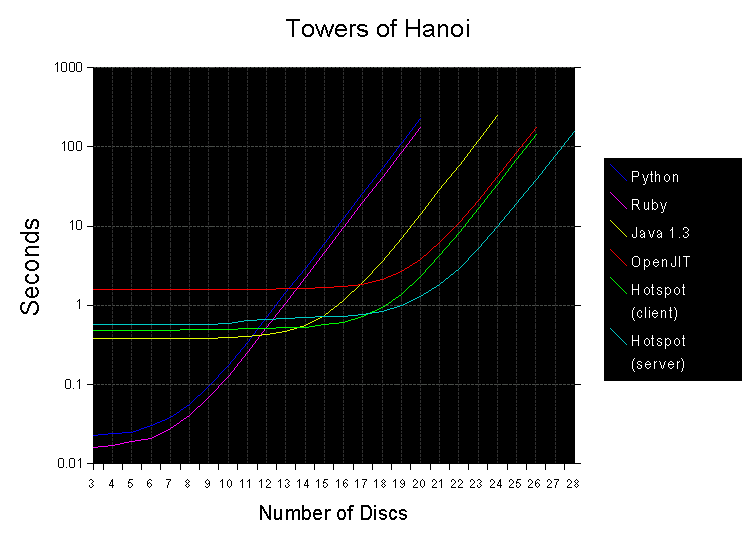Comparative Performance of Popular Object-Oriented Languages on a Trivial "Business Object" Benchmark


| Hardware: | Dell Inspiron 5000e 800Mhz PIII 512MB PC100 RAM |
| Operating System: | FreeBSD 5.0-CURRENT (2000-12-30) |
| Python: | Python 1.5.2, native compilation |
| Ruby: | Ruby 1.6.2, native compilation |
| Java 1.3: | Linux JDK build 1.3.0, Classic VM, green threads, OS emulation |
| OpenJIT: | OpenJIT 1.1.15, semi-native compilation |
The motivation for this test was to determine the relative execution speed of the various languages and virtual machines on a mix of operations representative of business logic.
These classes and methods were then implemented as similarly as possible in Python, Ruby, and Java. The user+system time was recorded for each VM with an increasing number of discs until execution time exceeded 100 seconds.
The graph shows that both Python and Ruby have very low startup overhead, but also very low sustained execution speed. Ruby is marginally faster than Python in both respects.
The Java "Classic" VM has the lowest startup overhead of the three Java VM's, but is around six times slower in sustained execution. The OpenJIT compiler increases startup time of the Classic VM considerably, but allows the Classic VM to approach the performance of the Hotspot client VM in sustained execution. This is significant because the Hotspot virtual machines require a threaded kernel for proper operation, and are thus not suitable for general use on FreeBSD. The OpenJIT compiler is currently the fastest option available for business object development under FreeBSD.
The Hotspot server VM performs surprisingly well, almost four times faster than the Hotspot client VM, and almost twenty-five times faster than the plain Classic VM in sustained execution.
Numeric results:
|
Discs |
Python |
Ruby |
Java 1.3 |
OpenJIT |
Hotspot |
Hotspot |
|
3 |
0.0230 |
0.0160 |
0.3790 |
1.5950 |
0.4840 |
0.5740 |
|
4 |
0.0240 |
0.0170 |
0.3770 |
1.5910 |
0.4840 |
0.5770 |
|
5 |
0.0250 |
0.0190 |
0.3800 |
1.5950 |
0.4850 |
0.5760 |
|
6 |
0.0300 |
0.0210 |
0.3820 |
1.5950 |
0.4850 |
0.5780 |
|
7 |
0.0380 |
0.0280 |
0.3810 |
1.5970 |
0.4860 |
0.5780 |
|
8 |
0.0560 |
0.0410 |
0.3820 |
1.5970 |
0.4890 |
0.5790 |
|
9 |
0.0940 |
0.0690 |
0.3860 |
1.5990 |
0.4940 |
0.5810 |
|
10 |
0.1730 |
0.1280 |
0.3910 |
1.6000 |
0.4960 |
0.5870 |
|
11 |
0.3400 |
0.2510 |
0.4010 |
1.6020 |
0.5060 |
0.6400 |
|
12 |
0.7020 |
0.5230 |
0.4240 |
1.6040 |
0.5160 |
0.6630 |
|
13 |
1.4400 |
1.0700 |
0.4710 |
1.6150 |
0.5300 |
0.6780 |
|
14 |
2.8770 |
2.2270 |
0.5600 |
1.6320 |
0.5330 |
0.7010 |
|
15 |
5.9750 |
4.6040 |
0.7510 |
1.6620 |
0.5680 |
0.7160 |
|
16 |
12.4300 |
9.5210 |
1.1500 |
1.7260 |
0.6120 |
0.7310 |
|
17 |
25.8310 |
19.7040 |
1.9530 |
1.8570 |
0.7280 |
0.7610 |
|
18 |
53.5760 |
40.7300 |
3.6240 |
2.1250 |
0.9280 |
0.8300 |
|
19 |
111.3050 |
84.1170 |
7.0570 |
2.6780 |
1.3900 |
0.9860 |
|
20 |
230.4530 |
173.6720 |
14.1560 |
3.8250 |
2.3390 |
1.2800 |
|
21 |
-- |
-- |
28.7370 |
6.1580 |
4.2670 |
1.8370 |
|
22 |
-- |
-- |
58.8030 |
11.0370 |
8.3050 |
2.9130 |
|
23 |
-- |
-- |
120.5990 |
21.1150 |
16.7290 |
5.2690 |
|
24 |
-- |
-- |
247.0070 |
42.0320 |
33.7470 |
9.9800 |
|
25 |
-- |
-- |
-- |
85.1880 |
69.1380 |
19.5090 |
|
26 |
-- |
-- |
-- |
174.3310 |
141.6330 |
38.9180 |
|
27 |
-- |
-- |
-- |
-- |
-- |
78.2340 |
|
28 |
-- |
-- |
-- |
-- |
-- |
157.5720 |